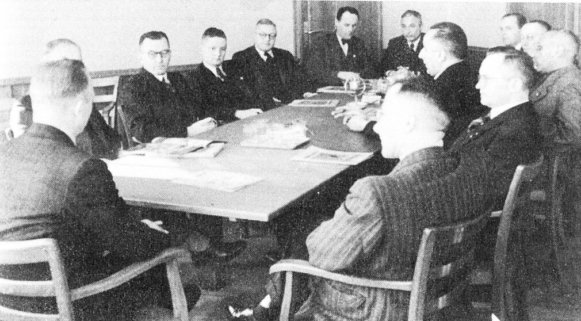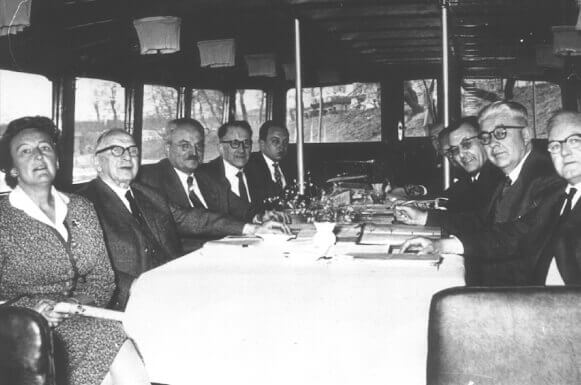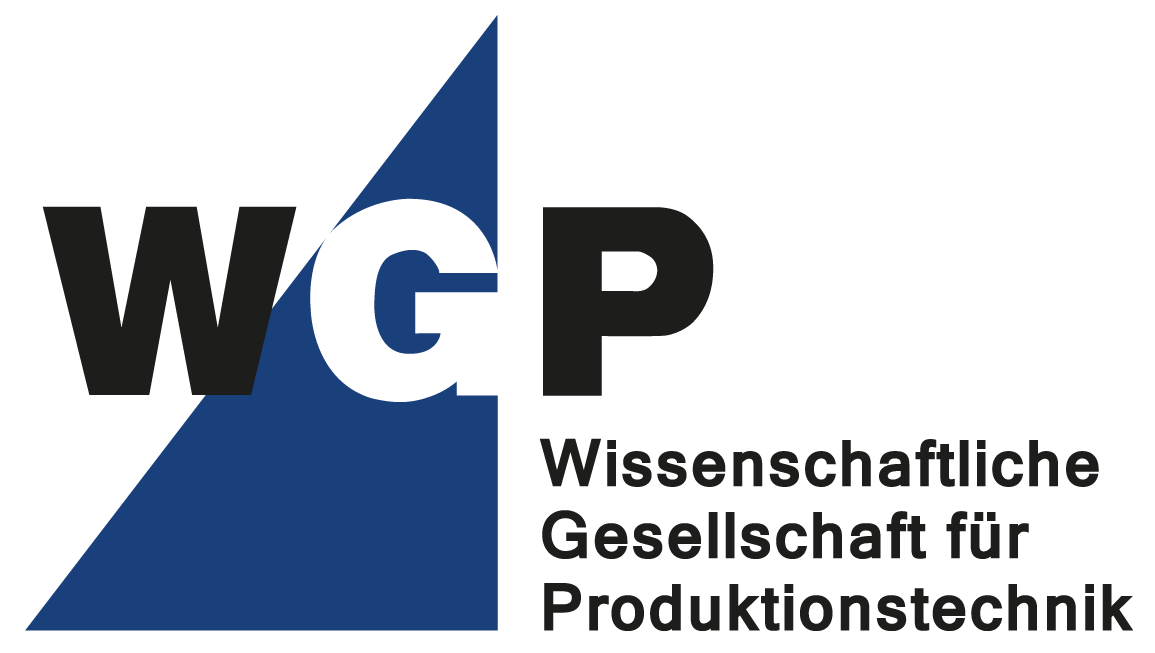85 Years of WGP
In March 1937 the German Academic Association for Production Technology (WGP) was founded initially as the University Group Science of Management (Hochschulgruppe Betriebswissenschaft – HGB), later the University Group Production Technology (Hochschulgruppe Fertigungstechnik – HGF) on the premises of the Association of Machine Tools (Verein Deutscher Werkzeugmaschinen) on the Messe Leipzig.
„We had no idea what was coming, but we had all mutually become more open and were willing to open up our institutes to each other and speak openly about current and planned work.“ [1]
Looking back, this sentence was formulated by one of the founding fathers of the WGP. Pronounced at a critical time, it has stayed throughout the changeful phases of the WGP history up to this day and it has promoted the bearing idea of a close connection between science and industry.

WGP professors attach great importance to exchange
Source: WZL, RWTH Aachen
Basis for „German workmanship“ created
Even if research was being influenced by the emerging war, some basic thoughts were already indicating future developments. For example, high quantity outputs and extensive rationalization were high aims to be scientifically supported. The mere description of production processes, which was customary up to the change of the century, was no longer sufficient. Its physical and technological foundations, the interaction of tool, material and machine had to be explored. Interchangeability was recognized as an important means of rationalization and promoted by papers on production measurement technology and standardization. In the field of tool machines, the renowned production technician Georg Schlesinger had already recognized the working precision of machines as decisive in 1927. He had defined it in his “Inspection Book of Tool Machines“ and, thus, most likely made a crucial contribution to the quality and acceptance of German tool machines on the market. Consequently, research on the dynamic and thermic behaviour of tool machines followed in the university group. Quality requirements and shortage of specialists due to war directed the focus on innovations for automatization.
Early research on automatization
In the first post-war years, teaching and youth development were the priority, one of the pillars of the university group. In research, the technological work of the war period was continued. For the further development of automation, mechanical, electric and first electronic controls were investigated. The search for new possibilities of rationalization for the production of medium and small series increased.
The breakthrough came from the USA in 1952 with the development of the numeric control at the MIT. Some years later, intensive research on this field began at the chairs of the university groups. The approach in the USA, exclusively oriented towards geometry data, was enhanced, here, by technological components.
A series of papers which were defined as a joint assignment of the university group were taken up and successfully introduced into industrial production and teaching, among these were adaptive controls (AC), computer-aided construction (CAD), computer-aided manufacturing (CAM) or also linking of machines in flexible fabrication systems (FFS) via hardware and software.
WGP advises associations and politics
The university group increasingly understood itself as a consultant and stimulator in questions of production for the political deciders. For example, WGP researchers discuss research activities that Germany should initiate and develops research initiatives together with the federal government.
For instance, in the 80’s the WGP was able to convince the Federal Ministry for Research and Technology to issue a nationwide programme for computer integrated manufacturing (CIM) and to set up a number of CIM transfer centres. Luckily, it was also possible to include the scientists of the new federal states after the fall of the Berlin Wall. The works in research, teaching and further training, which are possible in the CIM transfer centres, turned out to be important antecedents and components of extensive digitalization in the producing industry that is now operated under the title “Industry 4.0.“
Training of internationally sought-after managers
Since its existence, the WGP has also advocated for modern forms of knowledge transfer and the admission of current contents in teaching. One example for this is the origination of the WGP production academy in 2015 where company employees as well as students can graduate further trainings ranging from simulative-theoretical over practical-production-oriented up to economical-organizational. Therefore, the WGP can rightly claim to be training the internationally sought-after junior management for the German industry, too.
This is how the nationally and internationally recognized WGP has been meeting the important social challenges by means of its research, teaching and further training as well as by advising the political deciders for 80 years now. It is, thus, making an essential contribution to the excellence of the production location Germany.
[1] Kienzle, O.: 25 years of University Group Production Technology: 1937-1962. Speech, special print 1962

WGP Meeting in 1958 in Berlin on the MS Karo As
Source: WZL, RWTH Aachen
